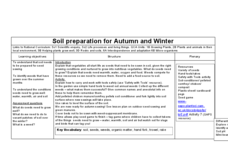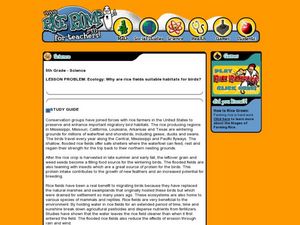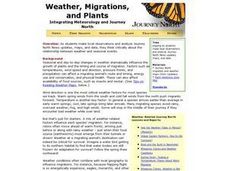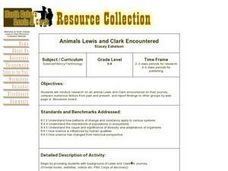Curated OER
Soil Preparation for Autumn and Winter
Students determine how and why soil needs to be prepared for the fall and winter seasons. In this agriculture lesson, students determine how to use gardening tools safely. They show how to work with compost material and fertilizer to...
Curated OER
Insect Challenge Project
In this biology instructional activity, students identify insects by their name and write it in the correct box on the sheet. Then they catch insects with nets and bring them in to identify. Students also earn points for the number of...
Curated OER
Ecology: Why Are Rice Fields Suitable Habitats for Birds?
Fifth graders discover the uses for rice by reading about the habitats of certain birds. In this agriculture instructional activity, 5th graders research birds from the Gulf Coast and California and their reasons for living in rice...
Curated OER
Exploring Limu Diversity
Young scholars explore limu diversity. In this ocean ecosystem lesson, students classify limu according to its physical properties. Young scholars work in small groups to generate scientific observations and sort limu by characteristics.
Curated OER
Rice: The Global Crop
Students understand the uniqueness of the rice plant and how it grows. Students compare rice growing in Indonesia and California, observing the steps common to the process everywhere. Students comprehend the concepts labor-intensive and...
Curated OER
A Natural Habitat: What, How and Why
Students understand what a habitat is. They determine why a habitat is important to our environment no matter where it is located. Students observe and recognize natural habitats in their surroundings.
Curated OER
Wetland Adaptation
Students participate in a simulation to investigate the impact of the wetland environment on the migration of birds. They discuss the patterns of migration they took and why they avoided certain wetlands.
Curated OER
How Does a Migration Move Forward?
Students record and examine migration data, and calculate how fast and far a migrating animal travels and what influences its progression. They utilize the Journey North website to follow their migrating animals.
Curated OER
Weather, Migrations, and Plants
Students research the effects of day-to-day weather on animal migrations, plant growth and other seasonal events. They consult maps, observe and record local conditions, keep journals and use their collected data check hypotheses.
Curated OER
Observing Brine Shrimp
Students observe brine shrimp eggs, create an appropriate environment for their survival, and observe their growth.
Curated OER
Threatened Species and Public Policy
Middle schoolers discuss the Endangered Species Act and its impact on people and the environment. They read the act and watch video footage. They examine why sea turtles are endangered and efforts to protect them. They analyze numerical...
Curated OER
Animals Lewis and Clark Encountered
Young scholars conduct research on an animal Lewis and Clark encountered on their journey, compare numerous factors from past and present, and report findings to other groups by web page or discussion board.
Curated OER
Wetland Wonders
Learners study the characteristics of wetlands, and their importance to humans and wildlife.
Curated OER
Bats, Bats, Everywhere!
Students research information on bats while working in cooperative groups. They design posters with the information from their research.
Curated OER
Life Cycles: A Never-Ending Story
Second graders describe the sequence of events in the life cycles of a butterfly, frog, and a deer. They observe the differences and similarities of parents and babies. They also discover that at different stages the animals can be...
Curated OER
Plains Indians
First graders create a KWL chart on Native Americans and listen to a speaker from a local Indian Reservation. As a class, they are read part of a Native American story in which they pick their own Native American name and identify their...

















